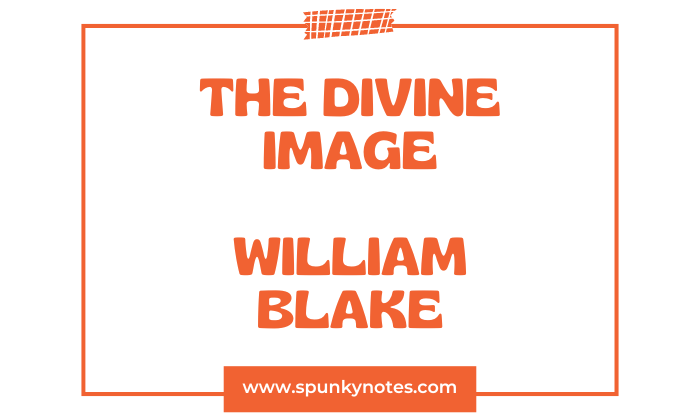

Estimated Reading Time: 7 min
Q. Analyse the poem The Divine Image by William Blake.
The Divine Image” is a poem by William Blake, published in his collection “Songs of Innocence” in 1789. The poem discusses divine qualities such as mercy, pity, peace, and love in humans.
It suggests that these virtues reflect God’s image within us. Blake proposes that recognizing these virtues in each other promotes unity and understanding, emphasizing the connection between humanity and the divine.
Analysis of The Divine Image by William Blake
Stanza 1
To Mercy, Pity, Peace, and Love
All pray in their distress;
And to these virtues of delight
Return their thankfulness.
To Mercy, Pity, Peace, and Love
The poem starts by naming four virtues: Mercy, Pity, Peace, and Love. These virtues are personified and treated as if they are beings or entities to whom one can speak or pray.
This personification elevates their importance and gives them a sacred or divine quality.
All pray in their distress;
Blake states that all people, regardless of their background or beliefs, turn to these virtues when suffering or in trouble.
The word “distress” encompasses various human suffering, from physical pain to emotional turmoil. This line emphasizes the universal nature of these virtues as sources of comfort and relief.
And to these virtues of delight
The virtues are described as sources of “delight.” It is interesting because it goes beyond the idea of these virtues as mere remedies for distress; they are also sources of positive joy and happiness.
Return their thankfulness.
This line suggests that when people are relieved from their distress, they feel and express gratitude towards these virtues.
This gratitude completes a spiritual cycle: in distress, people turn to these virtues, and upon finding relief, they return thanks.
Stanza 2
For Mercy, Pity, Peace, and Love
Is God, our father dear,
And Mercy, Pity, Peace, and Love
Is Man, his child and care.
For Mercy, Pity, Peace, and Love
Repeating the list of virtues, Blake reinforces their significance. The repetition serves as a poetic device to emphasize the importance of these qualities in the poem’s context.
Is God, our father dear,
Here, Blake directly connects these virtues and God, portraying them as not just qualities endorsed by God but as embodying God Himself.
The phrase “our father dear” adds a sense of intimacy and affection, presenting God as a loving, caring figure who is not distant or detached.
And Mercy, Pity, Peace, and Love,
Again, the repetition of these virtues underscores their central role in the poem. Blake draws a parallel structure in the following line to emphasize a crucial point.
Is Man, his child and care.
This line equates the virtues of Mercy, Pity, Peace, and Love with humanity (Man). Blake suggests that these divine qualities are inherent in humans, who are portrayed as God’s children and the focus of his care.
This line implies a similarity between the divine and the human. It suggests that these virtues are as essential to human nature as to God.
Blake blurs the lines between the divine and the human, suggesting that the best of what we perceive as divine qualities are also found within humanity.
This perspective is quite radical for Blake’s time, as it diminishes the traditional gap between a transcendent God and fallible humans.
Stanza 3
For Mercy has a human heart,
Pity a human face,
And Love, the human form divine,
And Peace, the human dress.
For Mercy has a human heart,
Blake personifies Mercy with a human heart, suggesting that forgiveness is deeply rooted in human nature.
The heart is often seen as the seat of emotion, so by saying that Mercy has a “human heart,” Blake implies that the capacity for Mercy is an inherent and emotional part of being human.
Pity a human face,
In this line, pity is given a human face. Faces are expressive and the primary way we recognize and understand each other’s emotions.
By attributing a human face to Pity, Blake emphasizes the empathetic nature of this virtue, a quality that allows humans to perceive and respond to the suffering of others.
And Love, the human form divine,
Blake believes that God is not a distant figure but exists within human love and kindness. People show their true divine nature by loving others and becoming closer to God.
It implies that Love is humans’ most holy and godlike quality, a trait that connects the human and the divine.
And Peace, the human dress.
Peace is portrayed as the “human dress,” suggesting that peace is what humans outwardly wear or present to the world.
This metaphor implies that peace is not just an internal virtue but also an external, visible one. It can be seen in actions, demeanor, and interactions with others.
Just as people wear clothes daily, they can also “wear” peace by acting with kindness, avoiding conflict, and promoting harmony in their lives.
Stanza 4
Then every man, of every clime,
That prays in his distress,
Prays to the human form divine,
Love, Mercy, Pity, Peace.
In these concluding lines of William Blake’s “The Divine Image,” the poet brings together the themes of universal human experience and the divine nature of virtues:
Then every man, of every clime,
Blake begins these lines by emphasizing universality. “Every man, of every clime” means all people, regardless of their geographic, cultural, or ethnic backgrounds.
That prays in his distress,
The reference to prayer in times of distress connects to the poem’s opening lines. It underscores the common human experience of seeking help or comfort in difficult times.
This line suggests that people naturally turn to higher virtues or powers in moments of suffering.
Prays to the human form divine,
Blake asserts that when people pray in distress, they are, perhaps unknowingly, praying to the “human form divine.” It is a profound statement, implying that the divine qualities people seek are found within humanity.
This means that instead of praying to a distant or separate God, people are really seeking the divine qualities that already exist within humanity.
Blake’s message is that true divinity is found in kindness, love, and compassion and that these virtues unite all people, regardless of religion or nationality.
Love, Mercy, Pity, Peace.
The poem concludes by reiterating these four virtues. This repetition cements their importance in the poem and their role as human and divine qualities.
By ending with these words, Blake reminds the reader of the virtues that he believes not only connect humanity to the divine but are essential qualities inherent in every person.
This idea speaks to the potential for goodness and virtue inherent in every person and suggests a deep interconnectedness among all human beings, transcending geographical and cultural boundaries.
Stanza 5
And all must love the human form,
In heathen, Turk, or Jew;
Where Mercy, Love, and Pity dwell
There God is dwelling too.
And all must love the human form,
This line emphasizes the importance of recognizing and respecting the divine in every human being. The word “must” here suggests a moral imperative, a necessary action for everyone.
In heathen, Turk, or Jew;
Blake mentions “heathen, Turk, or Jew” to include groups seen as outsiders and ‘others’ in his time.
“Heathen” was a term for pagans or those without a monotheistic religion. “Turk” was often used to refer to Muslims. “Jew” refers to Jewish individuals.
By naming these groups, Blake promotes universal brotherhood. He believes that every person has divinity, regardless of religion or background.
Where Mercy, Love, and Pity dwell
This line returns to the poem’s central virtues. Blake says that something sacred and essential happens wherever these qualities are present.
There God is dwelling too.
The poem concludes with the idea that the presence of Mercy, Love, and Pity indicates God’s presence.
Blake’s message is that God is not limited to one religion or belief system. Instead, God exists wherever there is Mercy, Love, and Pity.
This means that true divinity is found in human kindness, not in religious labels or divisions. We bring God’s presence into the world by loving and respecting all people.
It implies that God is immanent in human actions and feelings, especially those that reflect compassion, empathy, and Love. He suggests that it is essential to recognize the divine in every person, regardless of their cultural or religious identity.


